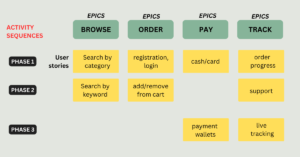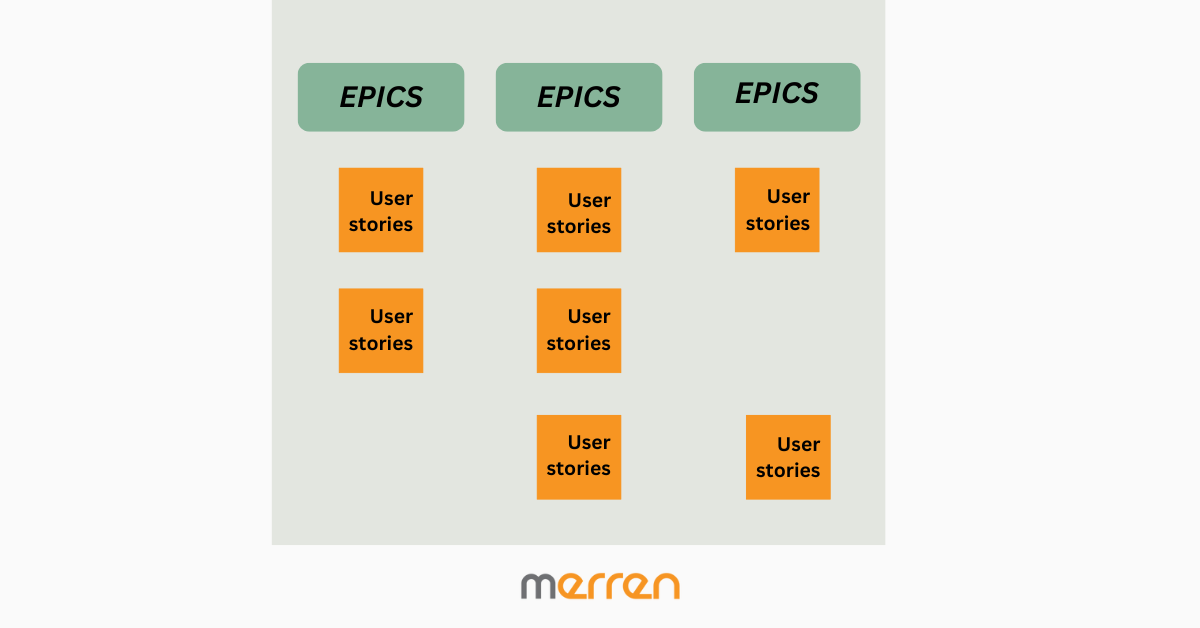When potential buyers are in a particular ecosystem, they go through a certain process of browsing and purchasing. This entire process will be similar to other potential clients. Let us say we are looking at a food ordering app. Users who will browse through the application will have a particular pathway to follow. This pathway will be the same for other users using the application. So how can the marketer visualize this process? This can be done by mapping the user story. User story mapping is a technique popularized by software leader Jeff Patton. In this blog, we will understand what is a user story mapping and how to create a user story map that will augment overall customer experience.
What is User Story Mapping?
User story mapping is an Agile software development technique that visually represents the user’s journey and prioritizes features. It aids in understanding the overall picture, making informed decisions, identifying product gaps, and ensuring user needs are met during development. Since every company has a mission and a vision, these ideals are connected to a specific roadmap. This roadmap will have a broad visualization of the user’s perspective while they are using the product.
Mapping the user’s story is keeping a systematic track of their first step till the last step of product usage. This includes their initial activity on the app, the overall user experience (ux) while using the product and how they intend to become loyal customers of the product. This activity will also determine if the product would require new features and upgrades within the existing product.
What isn’t user story mapping?
User story mapping is not a project management tool. It’s a process that requires proper user research and validation. It’s not a one-time activity, but an iterative process. It’s not just about creating visuals; it’s about gaining insights into the end-user’s journey. This mapping technique is also different from mapping the customer journey.
User story mapping for agile teams
User story mapping for agile teams is a powerful technique that allows cross-functional teams to collaborate effectively in visualizing and prioritizing the user journey through a product or service. By breaking down complex features into smaller user stories, teams can deliver value incrementally and promote continuous feedback and iterative development. With user story mapping, teams can gain a holistic understanding of the user’s needs, pain points, and desired outcomes, enabling them to make informed decisions about product development. This collaborative approach also facilitates effective backlog management and sprint planning for agile teams. User story mapping helps in creating a shared understanding among team members and ensures that everyone is working towards building the right product.
Anatomy of A User Story Map
User story mapping is a powerful technique that reflects the chronological order of events. With this technique, teams can better understand the flow of the product development process and identify any gaps or dependencies that may exist. The backbone of a user story map is formed by defining the main goals or themes of the project. This serves as a guide for the entire team and helps ensure that everyone is working towards a common objective. Additionally, user story maps can also serve as an effective communication tool to align stakeholders and team members.

A user persona
Organisations create a user persona(more like a potential audience) who will be the target customer for using the product. This persona or the target customer will come with a set of expectations and certain behaviours and preferences. To create a user persona, build a simple template of an imaginative person and which will depict their behaviours, pain points, current need gaps and their shopping preferences. A user persona will also have important demographic details of a probable target customer.
Minimum viable product
A minimum viable product or an MVP, is a collection of features that a product (it could be a mobile application or a physical product like a smartphone) should contain to make it functional for the customer base. MVP describes the total usability of a product. The product manager is responsible for creating important features that will be useful for the end customer. While it is important to give the best experiences for the people, new upgrades or iterations can be launched in various phases (example application updates on existing features).
Epics
Epics are progressive steps that a user follows while inside an ecosystem. Epics represent a large chunk of functionality or desired outcomes systematically. These are larger steps that help break down complex projects into manageable parts and provide a big-picture view of the project. Epics serve as placeholders for more detailed user stories and can be further decomposed into smaller user stories. By organizing user stories into epics, teams can better understand the scope of their project, track progress, and ensure that they are delivering value to customers.
User stories
User stories play a crucial role in agile software development. They are concise descriptions of features or functionality from the perspective of the end user. By breaking down larger features into smaller, more manageable user stories, teams can effectively plan and develop software products. User stories should be written collaboratively with input from stakeholders, developers, and designers to ensure a comprehensive understanding of user needs. This collaborative approach helps create a shared understanding among team members and promotes the delivery of the right product to users.

The Backbone of User Story Mapping
The foundation of user story mapping lies in its ability to visually comprehend and prioritize the functionality within a product or software. It encompasses the core user activities or objectives that the product aims to achieve. Breaking down these activities into smaller, manageable tasks empowers teams to efficiently prioritize and plan their efforts. This foundational structure serves as a roadmap for crafting comprehensive user stories, ensuring that every aspect of the product is accounted for during development.
Benefits of user story mapping
User story mapping offers several advantages in the product development process. It allows teams to gain a visual understanding of the user journey, fostering collaboration and alignment among various stakeholders. With user story mapping, teams can prioritize features and identify any gaps or missing functionalities in their product or service. This practice also helps create a shared understanding of the project scope and requirements. Furthermore, user story mapping enables iterative development based on valuable user feedback, ensuring that the final product meets user needs effectively.
What is A Flat Backlog?
Flat backlog is very different from a user story mapping. Flat backlog is a collection of ‘things to do’ mostly in a project or product management software. It does not encapsulate the overall roadmap features of a general story mapping activity. Flat backlog has a collection of future sprints that will contain the smallest unit of work and details of what will be delivered in the coming timeline. These are tasks that the development team will mostly work on based on critical assessments and estimates.
A flat backlog comes with its disadvantages. It may not always provide ample context into user experiences and what the customer might expect in the future. There is also a major problem of priority listing- where you cannot determine which issue to solve or what feature to build first. It boils down to the nitty gritties of product development. With a flat backlog method, the product manager cannot determine if they have identified the user stories in the total roadmap.

Story Mapping by The Marketer
User story mapping, also known as story mapping or a user story map, is a powerful technique used in agile software development. It is especially valuable when planning a new product or feature. Instead of simply listing out tasks in a backlog or sprint plan, user story mapping helps teams visualize the bigger picture from the perspective of the user. Marketers can create a physical story map over a whiteboard to create visuals of a customer journey within the product. One can mention the epics over post-its and segregate each head plan into smaller units on the basis of what action a user takes inside each epic.
Who should be involved in user story mapping?
User story mapping should involve a collaborative effort from various stakeholders, including product owners, developers, and designers. However, it’s crucial to include other key individuals such as users, customers, and subject matter experts to bring diverse perspectives and capture comprehensive user needs. By involving the right people in the process, organisations can see the bigger picture of each map and find ways to bring more customer value in the ecosystem.
To add to the team effort, we also recommend seeking market insights by means of survey collection and data gathering. After all, it is crucial to understand if customers would be keen to test out your product or welcome a certain upgrade for their benefit. However, in the quest of seeking market approval, avoid over-surveying respondents as it could bring survey fatigue and prevent marketers from actually executing the plan.
Conclusion
A user story map will have important touchpoints akin to the moment of truth where customers will interact with each feature through the purchase journey. To create a seamless journey for the people, creating a waterfall method of an agile framework can help build a clear roadmap.
Want to capture how customers feel about using your product? Sign up for a 14 day free trial with Merren and give it a go! We have robust tools for customer journey mapping that can capture word of mouth analytics and bring real time data to your dashboard. Build your own Whatsapp surveys and AMP email surveys and view results graphically and in real time.





